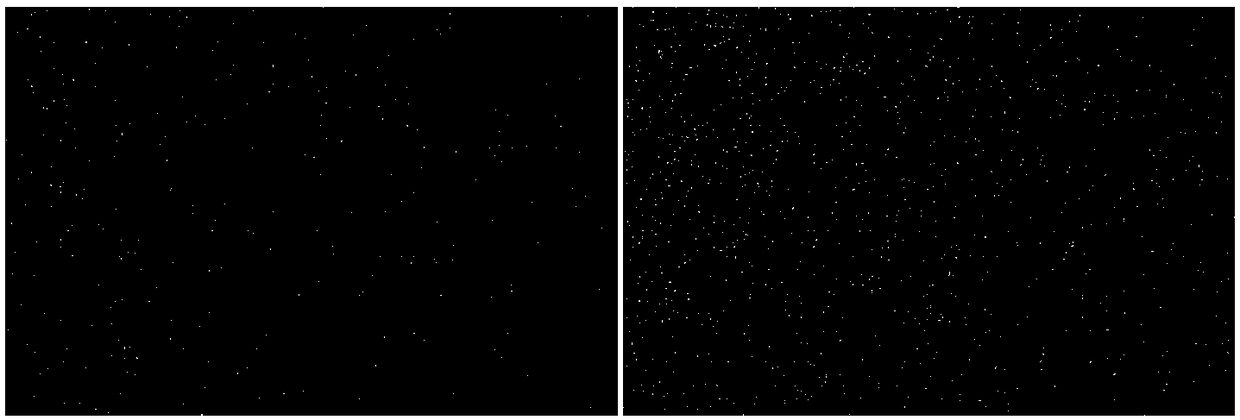Preparation method of palladium nano-clusters with sizes controllable
A palladium nano-size technology, applied in the field of preparation of palladium metal nano-clusters, can solve the problems of preparation of different sizes, complex operation, cumbersome steps, etc., and achieve the effect of easy control and simple operation
- Summary
- Abstract
- Description
- Claims
- Application Information
AI Technical Summary
Problems solved by technology
Method used
Image
Examples
example 1
[0017] Example 1: Synthesis of 0.6-0.9nm Palladium Nanoparticles
[0018] First dissolve 20mg of palladium chloride in 0.5mL of concentrated hydrochloric acid, then add 20mL of methanol solvent and stir for 40 minutes, then add a thiol ligand with a molar ratio of 3:1 for reaction, wait for one hour to react, and add a molar ratio of 5:1 Sodium borohydride reduction yields zero-valent palladium nanoparticles. The obtained palladium nanocluster solution was spin-dried, and then washed 3 times with a large amount of methanol. Finally, the palladium nanoparticles were dissolved in dichloromethane, centrifuged at 9000 r / min, and spin-dried.
[0019] Such as figure 1 , Embodiment 1 prepares the transmission electron micrograph of palladium nanoparticle, and the size of its palladium atom is 0.6-0.9nm.
example 2
[0020] Example 2: Synthesis of 1.0-1.3nm palladium nanoclusters
[0021] First dissolve 20mg of palladium chloride in 0.5mL of concentrated hydrochloric acid, then add 20mL of methanol solvent and stir for 40 minutes, then add a thiol ligand with a molar ratio of 2:1 for reaction, wait for one hour to react, and add a molar ratio of 5:1 Sodium borohydride reduction yields zero-valent palladium nanoparticles. The obtained palladium nanocluster solution was spin-dried, and then washed 3 times with a large amount of methanol. Finally, the palladium nanoparticles were dissolved in dichloromethane, centrifuged at 9000 r / min, and spin-dried.
[0022] Such as figure 2 , Embodiment 2 prepares the transmission electron micrograph of palladium nanoparticle, and the size of its palladium atom is 1.0-1.3nm.
example 3
[0023] Example 3: Synthesis of 1.4-1.7nm Palladium Nanoparticles
[0024] First dissolve 20mg of palladium chloride in 0.5mL of concentrated hydrochloric acid, then add 20mL of methanol solvent and stir for 40 minutes, then add a thiol ligand with a molar ratio of 1:1 for reaction, wait for one hour to react, and add a molar ratio of 5:1 Sodium borohydride reduction yields zero-valent palladium nanoparticles. The obtained palladium nanocluster solution was spin-dried, and then washed 3 times with a large amount of methanol. Finally, the palladium nanoparticles were dissolved in dichloromethane, centrifuged at 9000 r / min, and spin-dried.
[0025] Such as image 3 , Embodiment 3 prepares the transmission electron micrograph of palladium nanoparticle, and the size of its palladium atom is 1.4-1.7nm.
PUM
| Property | Measurement | Unit |
|---|---|---|
| size | aaaaa | aaaaa |
| size | aaaaa | aaaaa |
| size | aaaaa | aaaaa |
Abstract
Description
Claims
Application Information
 Login to View More
Login to View More - R&D
- Intellectual Property
- Life Sciences
- Materials
- Tech Scout
- Unparalleled Data Quality
- Higher Quality Content
- 60% Fewer Hallucinations
Browse by: Latest US Patents, China's latest patents, Technical Efficacy Thesaurus, Application Domain, Technology Topic, Popular Technical Reports.
© 2025 PatSnap. All rights reserved.Legal|Privacy policy|Modern Slavery Act Transparency Statement|Sitemap|About US| Contact US: help@patsnap.com



